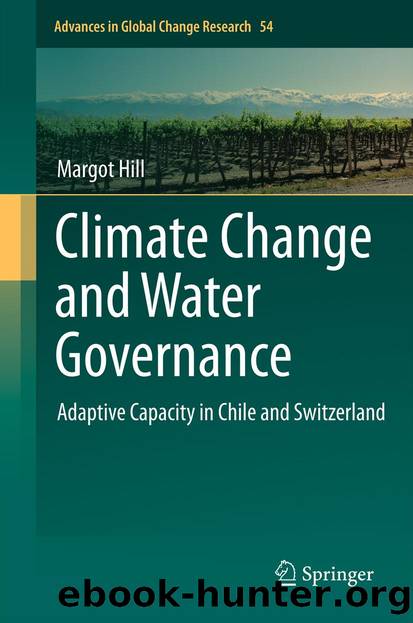Climate Change and Water Governance by Margot Hill

Author:Margot Hill
Language: eng
Format: epub
Publisher: Springer Netherlands, Dordrecht
9.1.2 Converging Threats: Non-climatic Drivers
In addition to the specific impacts from climate related stresses as detailed above, there are a number management related challenges that were identified through the coding exercise as converging threats within the basin. Most of these issues have already been addressed in Chaps. 1 and 4 and were presented through the broad governance context in relation to indicators of good governance and IWRM (Chap. 5). The issues highlighted in this section (and in the following Chilean section) relate mainly to specific geographical, demographic and infrastructural issues that interact with the climate driven issues and so in some respects are difficult to separate from the climatic drivers of adaptation responses (see Sect. 6.2.1 for a definition of response).
Perhaps the biggest management challenge for the mountain municipalities is the issue of periodic rivalries. Peak period demand, when water flows are at their lowest, are precisely when water demand is at its highest. For example, in Zermatt and Les Bagnes, 90% of demand is during winter and notably at specific points during winter. This requires a commune with a population of 3,000–6,000 to be able to cover water supply for an intermittent population of 30,000 over the course of a few weeks during the winter season (December–April), when the springs are at their lower. This has caused some local water managers to suggest that the communes will in the future need to rely more heavily on exploiting groundwater sources (Zermatt is currently fully dependant on spring water), if demand keeps rising, and their ability to recharge the springs during summer diminishes. A related impact of tourism peaks is the steady rise of electricity demand, which has risen by 3% per year for the previous 5 years, the majority in winter (EWZ 2010).
Despite the strong principles of decentralisation that defines the Swiss governance framework, concentrations of power have gradually been shifting from lower to higher levels of government as well as across private and public sector responsibility. Certain services that used to be the responsibility of private actors at the commune level have now been transferred to the public realm either at the commune or cantonal level, most notably after the 2000 flooding events. For example, reconstruction and repair of damages from extreme weather events is no longer managed privately as remediation work was so extensive it required the structure and support of the commune or cantonal authorities. In the aftermath of the 2000 event in Baltschieder, the commune and canton collaborated to take over the clean-up operation, rebuilding the streams and repairing the canalisation network. After the 1993 events, there was a realisation that the damage costs were so high, that the communes did not have the financial capacity to cover the bill. The canton therefore took responsibility for remediation costs, later sourcing percentages of repayment from both federal and commune authorities.
Despite these shifting demographic and political structures, traditional associations for the water irrigation channels have tended to remain, yet in a weakened form. As agriculture and the number
Download
This site does not store any files on its server. We only index and link to content provided by other sites. Please contact the content providers to delete copyright contents if any and email us, we'll remove relevant links or contents immediately.
| Automotive | Engineering |
| Transportation |
Whiskies Galore by Ian Buxton(41533)
Introduction to Aircraft Design (Cambridge Aerospace Series) by John P. Fielding(32890)
Small Unmanned Fixed-wing Aircraft Design by Andrew J. Keane Andras Sobester James P. Scanlan & András Sóbester & James P. Scanlan(32574)
Craft Beer for the Homebrewer by Michael Agnew(17935)
Turbulence by E. J. Noyes(7702)
The Complete Stick Figure Physics Tutorials by Allen Sarah(7143)
Kaplan MCAT General Chemistry Review by Kaplan(6597)
The Thirst by Nesbo Jo(6439)
Bad Blood by John Carreyrou(6278)
Modelling of Convective Heat and Mass Transfer in Rotating Flows by Igor V. Shevchuk(6225)
Learning SQL by Alan Beaulieu(6037)
Weapons of Math Destruction by Cathy O'Neil(5832)
Man-made Catastrophes and Risk Information Concealment by Dmitry Chernov & Didier Sornette(5650)
Digital Minimalism by Cal Newport;(5392)
Life 3.0: Being Human in the Age of Artificial Intelligence by Tegmark Max(5189)
iGen by Jean M. Twenge(5163)
Secrets of Antigravity Propulsion: Tesla, UFOs, and Classified Aerospace Technology by Ph.D. Paul A. Laviolette(4994)
Design of Trajectory Optimization Approach for Space Maneuver Vehicle Skip Entry Problems by Runqi Chai & Al Savvaris & Antonios Tsourdos & Senchun Chai(4843)
Electronic Devices & Circuits by Jacob Millman & Christos C. Halkias(4749)
